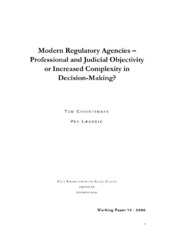| dc.contributor.author | Christensen, Tom | eng |
| dc.contributor.author | Lægreid, Per | eng |
| dc.date.accessioned | 2007-01-03T08:46:19Z | |
| dc.date.accessioned | 2020-12-10T06:31:24Z | |
| dc.date.available | 2007-01-03T08:46:19Z | |
| dc.date.available | 2020-12-10T06:31:24Z | |
| dc.date.issued | 2006-12 | eng |
| dc.identifier.issn | 1503-0946 | |
| dc.identifier.uri | https://hdl.handle.net/1956/2039 | |
| dc.description.abstract | In this paper we examine the preconditions for fulfilling the aims of the regulatory reform in the case of Norway by comparing different decision-making processes in regulatory agencies. We cover both the process of regulatory reorganization and decision-making within established regulatory structures. Our theoretical point of departure is that regulatory agencies operate in a complex political-administrative context and that we must combine instrumental and institutional perspectives to understand how they work in practice. We start by contrasting the rational-economic approach with a broad transformative perspective that embraces organizationalstructural elements, cultural components and features from the institutional environment Second, we give a brief outline of the context in which agencies operate and administrative reforms have been implemented in Norway. Third, we describe how a new regulatory reform policy has been introduced in Norway over the last three years. Fourth, we focus on agency reform processes in two policy areas and on regulatory practice in two regulatory agencies as case studies. Fifth, we discuss regulatory reform processes and practice from different theoretical perspectives. Finally, we draw some conclusions and address their implications. The main picture is that there is a loose coupling between the OECD regulatory policy ideal and a) general Norwegian regulatory policy; b) the reorganization of regulatory agencies in specific policy areas; and c) regulatory practice in individual cases. | en_US |
| dc.description.abstract | I dette notatet undersøker vi vilkårene for å gjennomføre den nye regulerings- og tilsynspolitikken i Norge. Vi undersøker både prosessen i forbindelse med regjeringens tilsynsmelding og beslutningsprosser i forbindelse med utvalgte tilsyn. Vi argumenterer for at reguleringsorganene opererer i en kompleks politisk-administrativ kontekst, og at vi må kombinere instrumentelle og institusjonelle perspektiver for å forstå hvordan de fungerer i praksis. En rasjonell-økonomisk tilnærming holdes opp mot en transformativ tilnærming som omfatter organisasjonsstrukturelle elementer, kulturelle komponenter og trekk ved institusjonaliserte omgivelser. Vi beskriver hvordan den nye reguleringspolitikken ble introdusert i Norge og fokuserer på reformer av tilsynsorgan i to sektorer så vel som reguleringspraksis i to tilsynsorgan. Hovedbildet er at det er en løs kopling mellom det idealet som OECD reguleringsreformer forutsetter og a) den generelle tilsynspolitikk i Norge, b) reorganisering av tilsynsorgan i utvalgte sektorer og c) hvordan reguleringspraksisen utøves i utvalgte tilsyn i konkrete saker. | no |
| dc.format.extent | 455752 bytes | eng |
| dc.format.mimetype | application/pdf | eng |
| dc.language.iso | eng | eng |
| dc.publisher | Stein Rokkan Centre for Social Studies | eng |
| dc.relation.ispartofseries | 12-2006 | |
| dc.relation.ispartofseries | Working Paper | en |
| dc.title | Modern Regulatory Agencies - Professional and Judicial Objectivity or Increased Complexity in Decision-Making? | eng |
| dc.type | Working paper | eng |
| dc.subject.nsi | VDP::Samfunnsvitenskap: 200 | nob |
